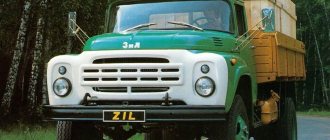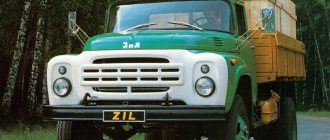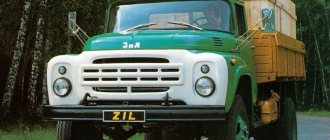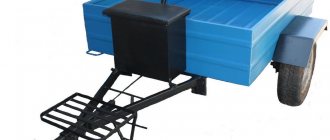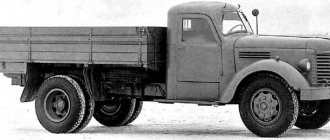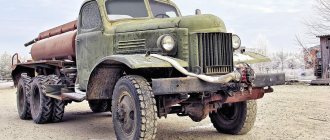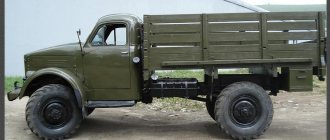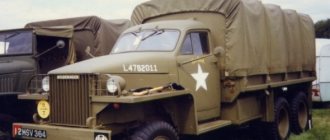We can talk about the legendary ZIL 130th model for hours. It all started in the post-war years, when the Soviet Union needed equipment for agricultural needs. This Soviet, and later Russian car, replaced the old ZIL-164 model, which was initially produced as the ZIS-150. Before the model became what we know it to be, quite a few changes were made to it. Before the restructuring of the Stalin plant, the model was produced as the ZIS-125.
As a product of the Likhachev plant, it was produced from 1962 to 2010. Initially, assembly was carried out in Moscow, but in the 90s the facilities were moved to Novouralsk. There the car was produced under a different name, Amur. It is noteworthy that the ZIL-130 became the first truck of its kind to be painted white and blue. Before this, all ZILs were painted khaki, since they were created for military purposes. The entire ZIL model range.
Appearance
The foreshadowing versions of ZIL trucks were extremely unfinished and crude. The justification is compelling; a large amount of equipment was required to repair damage after the war. But in the end, already in 1956, prototypes were significantly more beautiful than their predecessors.
After a number of regular changes, which concerned both the restyling of the truck and the plant itself, the ZIL-130 was presented at the annual international fair in Leipzig, where it received a gold medal, and the engineers received many diplomas. Since that time, the “130” model began to gain unprecedented popularity.
The fact is that ZIL dump trucks had quite a lot of modifications. The most commonly used of these were semi-trailers and articulated dump trucks. The most significant modifications were made in 1966 and 1977. On the basis of the usual “one hundred and thirty”, fire engines and truck cranes, tank trucks and vans, flatbed vehicles and construction dump trucks were created.
The car is efficient even in cramped urban environments thanks to its turning radius of up to 7 meters. Having a carrying capacity of only 3 tons, the ZIL-130 itself weighs at least 4 tons. At the same time, it can be used to tow a trailer weighing no more than 8 tons. From the outside, the Russian truck looked very good for that time. The car was capable of attracting attention.
It was painted white and blue. Before the ZIL-130, all automobile enterprises worked only for the defense and army spectrum, based on this, the car had a protective paint. The hood was alligator style. ZIL received streamlined wings and a panoramic windshield. In addition, the cabin was equipped with a ventilation hatch and windows.
Body
The body was supplied with a folding tailgate and was considered a cargo-passenger one. The gratings located on the sides were equipped with benches that could be folded back. They could fit 16 people. There was also a bench that could be removed - it could seat 8 people.
The basic modification of the ZIL-130 includes an awning along with arches, which can be removed and installed at any time. The body design is also practical. The height of the floor of the cargo compartment of the ZIL-130 is similar to the height of the floor in railway cars. This fact greatly simplifies the loading and unloading process.
Additional equipment included blackout for military versions, canisters, an ax, and a shovel.
Review of the Russian automotive industry and forecast for further development
| 4 | REVIEW OF THE RUSSIAN AUTOMOTIVE INDUSTRY AND FORECAST FOR FURTHER DEVELOPMENT |
| 4 | Cars |
| 7 | Trucks |
| 10 | Buses |
| 13 | PRODUCTION AND SHIPPING.
|
| 13 | Automotive production |
| 13 | Comparative production figures |
| 13 | Wholesale sale (factory shipment) of vehicles |
| 14 | Dynamics of production and shipment of vehicles in Russia |
| 15 | CAR PRODUCTION by manufacturers in Russia |
| 15 | TRUCKS |
| 22 | CARS OF FOREIGN BRANDS |
| 23 | Standard of the Association of Russian Automobile Manufacturers STOAR-001-2006 Classification of trucks |
| 24 | PASSENGER CARS |
| 29 | PASSENGER CARS OF FOREIGN BRANDS |
| 30 | Standard of the Russian Automobile Manufacturers Association STOAR-001-2006 Classification of passenger cars |
| 31 | BUSES |
| 35 | BUSES OF FOREIGN BRANDS |
| 35 | AUTOMATIC ASSEMBLY KITS |
| 36 | Standard of the Association of Russian Automobile Manufacturers STOAR-001-2006 Classification of buses |
| 37 | LIGHT COMMERCIAL VEHICLES |
| 38 | TROLLEYBUSES |
| 39 | EXPORT AND IMPORT OF CARS.
|
| 39 | EXPORT FROM RUSSIA (units, million US dollars) |
| 39 | IMPORT TO RUSSIA (units, million US dollars) |
| 40 | EXPORT OF VEHICLES |
| 40 | EXPORT OF VEHICLES (pcs.) |
| 40 | EXPORT OF VEHICLES (thousand rubles) |
| 41 | WHOLESALE (FACTORY SHIPMENT) OF CARS OF RUSSIAN MANUFACTURERS |
| 41 | SHIPPING OF THE CAR (including chassis) |
| 44 | SHIPPING PASSENGER VEHICLES |
| 47 | TRANSPORTATION/TRAINING BUSES |
| 50 | SHIPPING TROLLEYBUSES |
| 51 | |
| 51 | Belarus |
| 51 | TRUCKS |
| 51 | PASSENGER CARS |
| 51 | BUSES |
| 52 | TROLLEYBUSES |
| 52 | ROAD TRACTORS |
| 52 | Uzbekistan |
| 52 | PASSENGER CARS |
| 52 | Ukraine |
| 52 | TRUCKS |
| 53 | PASSENGER CARS |
| 54 | BUSES |
| 54 | AUTOMATIC ASSEMBLY KITS |
| 54 | Azerbaijan |
| 54 | TRUCKS |
| 55 | SHIPPING OF VEHICLES by manufacturers of Belarus, Uzbekistan, Ukraine and Azerbaijan |
| 55 | Belarus |
| 55 | TRUCKS |
| 55 | PASSENGER CARS |
| 55 | BUSES |
| 55 | Uzbekistan |
| 55 | PASSENGER CARS (domestic market) |
| 55 | EXPORT OF CARS to Russia (pcs.
|
| 56 | Ukraine |
| 56 | PASSENGER CARS |
| 57 | STRUCTURE OF THE AUTO MARKET OF UKRAINE |
| 57 | Comparison of sales for 2009/2008 |
| APPLICATION: | |
| 58 | SALES OF NEW CARS AND LCVs IN RUSSIA |
| 59 | SALES OF NEW CARS AND LCVs IN RUSSIA BY MANUFACTURER GROUP |
| 60 | MARKET STRUCTURE BY CLASSES AND TYPES OF VEHICLES |
| 61 | Average sales prices of new cars in Russia and sales revenue in 2009 |
| 61 | Revenue from car sales by brand |
| 62 | BEST SELLING NEW CAR MODELS IN RUSSIA (TOP 100) |
| 64 | Import of passenger cars to Russia, 2009/2008 |
| 65 | Import of trucks to Russia, 2009/2008 |
| 66 | Import of buses to Russia, 2009/2008 |
| 67 | GLOBAL VEHICLE PRODUCTION BY COUNTRY AND TYPE (OICA data) |
| 67 | All cars |
| 68 | Cars |
| 69 | Light commercial vehicles (including SUVs in the Americas) |
| 70 | Heavy trucks |
| 71 | Heavy buses |
Cabin interior
The steering mechanism of the ZIL-130 was a screw with a special spherical nut plus a piston-rack. The hydraulic booster was built-in. The three-seater cabin is located immediately behind the engine. The seat is adjustable in length, height and backrest tilt. The main options in the cabin included a heater, a windshield wiper with two blades, and a glass washer. For the 60s, the cabin ergonomics are at the highest level. The instrument panel and functional instruments are located very conveniently for the driver.
The designers provided two ventilation hatches in the cabin roof. The radiator grille has become a memorable element. The cabin was made of solid metal and had three seats. The engineering staff did a great job, because the car was comfortable and was very different from many Soviet trucks. Drivers received improved conditions for performing their work.
It was much more comfortable to sit inside, because the changes also affected the width - it was increased by 1.2 meters when compared with the ZIL-164 model. Instruments and controls were optimally located in the spacious cabin. In addition, soft seats appeared - for the driver and for passengers (double). The driver's seat could now be adjusted in horizontal and vertical directions.
It was also possible to change the angle of the chair back and pillows. It was on the ZIL-130 that the hydraulic power steering wheel debuted. Thanks to this, not only the ease of driving the truck increased, but also its safety - if the front wheel broke, it was easier to keep the truck on the road.
Modifications
Dump truck
The dump truck is equipped with a Perkins 6.345 engine with a power of 140 hp. Diesel is used as the fuel liquid.
The hydraulic system of this model consists of a mechanical pump element, a power take-off shaft and a tank into which fuel is filled with a volume of 17 liters.
The shaft box is equipped with rear-wheel drive and transmits power of 4.5 hp. to the car transmission.
The gearbox has a drive that goes to the rear axle mechanism. It uses a dry, single-plate clutch. The gearbox transmits rated torque to the rear cart through the driveshaft.
The steering design uses a hydraulic power steering along with an intermediate type support mechanism.
Also installed here are batteries with a capacity of 90 Ah and an alternating current generator 32.3701.
Collective farmer
ZIL-554 Kolkhoznik is used in agriculture for transporting various bulk cargoes. The transport is equipped with 3 folding sides for unloading in 3 directions.
The cabin has 3 seats, the seats are sprung, so they can be adjusted in length for comfortable work. The cabin body is made of all-metal alloy. The curved shape of the windshield provides a wide viewing angle. Inside the cabin there is a soundproofing coating and a heating device for comfortable work in winter.
To cool the power unit, a liquid system with a volume of 21 liters is used.
The hydraulic system includes a reservoir for working fluid, a mechanical pumping element, and a hydraulic cylinder, which ensures uninterrupted operation of the mechanism for raising and lowering the car body.
Specifications
The ZIL-130 car was initially equipped with an eight-cylinder 4-stroke engine with a capacity of 148 horsepower (3000 rpm). The working volume reached 6 liters. The engine lubrication system was combined, with splash and pressure. The engine power supply system is forced, the cooling system is liquid.
The suspension was dependent, the frame consisted of steel spars with five cross members. Starter 1.5 hp turned on via a traction relay. Known to everyone, the ZIL-130 truck became a breakthrough in Soviet mechanical engineering. Along with it, three-seater cabins, a hydraulic power steering wheel, a gearbox that included helical gears and synchronizers, an engine pre-heater, glass washers and more appeared.
Power unit
ZIL-130 acquired a power unit, the design of which had much in common with the motor from the ZIL-111 modification. It was a V-shaped eight-cylinder engine, but with a smaller displacement, which was designed for 76 gasoline, which was already familiar at that time. The engine came with a 2-chamber K-88AE carburetor, with a falling flow, and a balanced float chamber. There was a rev limiter.
From the very beginning, an experimental type engine was proposed, which was carburetor and had a V-shaped cylinder arrangement. The volume was 5.2 liters. Such an engine was capable of developing up to 135 horsepower and 3200 rpm. The camber of the cylinder block was 90 degrees. However, during the debut tests it became clear that such power would not be enough and the ZIL-130 truck simply would not be able to achieve good dynamics.
Then work began on using 8 cylinders in the same V-shape. Such improvements made it possible to increase engine power to 150 horses. It was then that the decision was made to curtail the production of 6-cylinder units. The new engine allowed the car to reach speeds of up to 90 km/h. The valve position on this 4-stroke engine was at the top. The engine capacity was 6.0 liters and 3,000 rpm.
In 1974, it was decided to use a more economical engine type for some models. Thanks to this replacement, the truck's efficiency also increased. This unit was a ZIL-157 with 6 cylinders arranged in a row, the power was 110 horsepower. The engine continued to be powered by A-72 gasoline.
The device used an economizer design and a mechanical pump for acceleration. It is equipped with a pneumatic crankshaft speed regulator, which is centrifugal. Engine lubrication is carried out in a combined cycle. In practice, this occurs using pressure, spraying oils. At the initial stage, this mechanism included a device for deep filtration. It looked like a set of thin plates made of steel. For enhanced purification, a jet-driven centrifuge was used.
The fuel pump provided forced fuel to the engine.
It was designed like the B-9 diaphragm with a single exhaust valve and a pair of intake valves. The crankcase blower function is of a closed type. 2-stage air purification is carried out using a VM-16 filter. This engine was quite gluttonous - for a hundred it could eat from 30 - 40 liters. It is clear that at that time this was not a problem, since fuel cost a penny. But today, many truck owners have had to redesign their vehicles in order to reduce operating costs. A full 170-liter tank was only enough for 445 kilometers. Technical characteristics of diesel variations of ZIL
| Model | ZIL-MMZ-554 | ZIL-MMZ-555(A) | ZIL-MMZ-555K |
| Basic chassis | ZIL-130B/ZIL-130B2 | ZIL-130D(ZIL-130D1) | ZIL-130K |
| Engine | ZIL-130 | ZIL-130 | ZIL-157 |
| Engine horsepower | 150 | 150 | 110 |
| Engine power in kilowatts | 110,4 | 110,4 | 80,9 |
| Maximum torque(Newton meters) | 401,8 | 401,8 | 343 |
| Maximum speed | 90 | 90 | 90 |
| Fuel consumption N liters per 100 kilometers | 37 | 37 | 37 |
| Gearbox type | 5-speed manual | ||
| Dimensions | |||
| Wheelbase | 3 800 mm. | 3 300 mm. | 3 300 mm. |
| Car dimensions | |||
| Length | 6,675 mm. | 5 475 mm. | 5 475 mm. |
| Width | 2,500 mm. | 2,420 mm. | 2,420 mm. |
| Height | 2 400 mm. | 2,510 mm. | 2,510 mm. |
| Platform dimensions | |||
| Length | 3,752 mm. | ||
| Width | 2 325 mm. | ||
| Height | 575 mm. | ||
| Square | 8.7 m3 | ||
| Body volume m3 | 5 | 3 | 3 |
| Body lift angle | 50o | 55o | 55o |
| Wheel formula | 4*2 | 4*2 | 4*2 |
| Tire size | 260-508Р | 260-508Р | 260-508Р |
| Technical dimensions of truck cranes ZIL-130 KS-2561D and KS-2561DA | |||
| Base | ZIL-130 | ||
| Switch installation type | Main | Non-retractable boom | |
| Replaceable | With extended boom, with extended boom and jib | ||
| Main boom length | 8 m. | ||
| Departure | 3.3 – 7 m. | ||
| System load capacity | 1,6 | ||
| Ascent/Descent Speed | 02 – 5.3 m/s | ||
| Maximum lift height | 15 meters | ||
| Dimensions with boom lowered | |||
| Length | 10 600 mm. | ||
| Height | 3 650 mm. | ||
| Width | 2,500 mm. | ||
| Weight | 8.8 tons | ||
By the end of the 1980s, it became clear that it was extremely irrational for trucks to drive on gasoline. In order to switch the ZIL to cheaper fuel, all efforts were devoted to a new modernization of the engine. But unfortunately, it did not go further than testing and prototypes.
Gearbox and clutch
The car has a rear-wheel drive axle, uses a dry clutch with a single disc and a mechanical five-speed gearbox with a pair of synchronizers (in 2nd and 3rd and 4th and fifth gears) with constant gear mesh, except for 1st and reverse. This unit was new in the automotive industry and has undergone improvements.
The gearbox transmits torque from the engine to the rear axle using a driveshaft. The standard 130 and the extended one had two shafts with an intermediate support, which was attached to the frame. And the model with a short base was supplied with a single shaft that did not require an intermediate support.
The mechanical gearbox was designed in 1961. Already 6 years later, in 1967, the gearbox structure underwent minor changes - it was expected and it happened, the appearance of a front bearing for the driven shaft, the shaft journal changed its design. Instead of a needle type bearing, a separator was installed.
The restyled box did not have a retaining ring. In order to avoid water getting into the gearbox when the car is wading or during heavy rainfall, the gear shift knob has become insulated with a rubber seal, the shape of which resembles a cover and a clamp.
And a special paste allowed manufacturers to protect the gearbox and hatch covers, the surface of the oil sump and other parts of the device. Everything inside is ventilated using a ventilation tube. The box housing itself was made of the best cast iron, which significantly increased its service life. Hydraulic shock absorbers are used on the front axle, and telescopic shock absorbers on the rear axle.
Brake system
The ZIL-130 truck is equipped with drum-type brakes on all wheels. They operate under the influence of a pneumatic system. The air reserve is stored in a specialized tank under the pressure provided by a mechanical compressor.
It is brought into its operating position by the belt drive water pump pulley. The operation of a 2-cylinder compressor is 2000 rpm, which is 220 liters per minute. It is liquid cooled. The number of air cylinders is 2 pieces, 20 liters each. The parking brake also uses a drum that blocks the driveshaft.
Electrical system
The voltage of the electrical system is 12 volts. Power is supplied from a 6ST-90-EM battery. The number 90 in the name indicates the amount of AmCh. There were two types of generators: the most common 32.3701 (also found on trucks from other manufacturers, for example, KamAZ), provides a current of 60 amperes; for ZIL-157D the package included G108-V with a power of 60A.
The voltage regulator is PP350-A (3702), non-contact, semiconductor. The starter is ST130-AZ, found not only in ZIL products. Ignition distributor - R-137, with automatic ignition timing control through centrifugal vacuum regulators. Ignition coil – B114-B. Spark plugs – A11 with M14*12.5 thread.
Dimensions
The dimensions of the ZIL-130 are as follows: length – 6,672 mm, width – 2,500 mm, height – 2,400 mm. Ground clearance – 275 mm. Wheelbase – 3,800 mm. Rear track – 1,790 mm. Front track – 1,800 mm. The minimum turning radius is 8,900 mm. The body platform is 5.10 cubic meters in volume. The floor area is 8.72 square meters. Platform dimensions: width – 2,326 mm; length – 3,752 mm; height – 575 mm.
(PDF) Broadband photoluminescence in ceramics (Mg2SnO4 – SnO2): Cr system
SN Applied Sciences (2021) 3:125 | https://doi.
org/10.1007/s42452-021-04161-y Research Article Mg2SnO4 Nanophosphorus Controlled
. ECS J Solid State Sci Technol
7: R183 – R189
17. Kim KN, Jung HK, Park HD, Ki D (2002) High brightness of a new phosphor
emitting green color, Mg2SnO4: Mn. J Lumin 99:169–173
18. Kitaura M, Tani S, Mitsudo S, Kukui K (2010) Photoluminescence enhancement
in manganese-doped magnesium phosphorus stannate
force synthesized using millimeter wave irradiation. Radiat Meas
45: 503–505
19. Lei B, Li B, Wang X, Li W (2006) Green emitting long-lasting phosphorescent properties (LLP) of Mg2SnO4:Mn2+ phosphor. J
Lumin 118:173–178
20. Junior EBS, Lopez A., Pedro S.S., Sosman L.P. (2019) Photolumi-
non-rescence of Co2 + ions in tetrahedral sites of Mg2SnO4. Opt Mater
95: 109202
21. Cai J, Pang R, Yu Z, Liu L, Li C (2019) Preparation and luminescent properties
luminescent material in the near infrared range Mg2SnO4: Cr3 +.
Chin J Lumin 40:1505–1513
22. Zhang J, Qin Q, Yu M, Zhou M, Wang Y (2012) Photolumins—
light pulses, afterglow and upconversion - photostimulated lumines -
cents Mg2SnO4 phosphors doped with Eu3 +. J Lumin 132:23–26
23. Guo P, Peng L, Zhang W, Liu L, Xiong J (2015) Preparation and photoluminescent properties
Mg2SnO4 nanoparticles doped with Pr,
particles. J Inorg Mater 30:1172–1176
24. Bolzan AA, Fong C, Kennedy BJ, Howard CJ (1997) Structural
studies of rutile-type metal dioxides. Acta Crystallographica B
53: 373–380
25. Gu F, Wang XF, Song QF, Lu MQ, Qi YX, Zhou GJ, Xu D, Yuan DR.
(2003) Synthesis and luminescent properties of SnO2 nanoparticles.
tickle Chem Phys Lett 372:451–454
26. Garcia-Tesedor M., Maestre D., Cremades A., Piqueras J. (2016)
Effect of chromium doping on morphology and luminescence
SnO2 structures.
J Phys Chem C 120:22028–22034
27. Nikolov I., Mateos X, Guell F, Massons J., Nikolov V., Peshev P., Diaz
F (2004) Optical properties of Cr3+ crystals: NaAl (WO4) 2. new candidate
for broadband laser applications. Opt Mater 25:53–58
28. Xu X, Shao Q, Yao L, Dong Y, Jiang J (2020) Highly efficient and
Thermally stable silicate phosphors activated with Cr3+ for broadband use
near-infrared LED applications. Chem Eng J 383:123108
29. Katayama Y, Kobayashi H, Tanabe S (2015) Dark red persistent luminescence
in Cr3+-doped LaAlO3 perovskite phosphor for imaging
vivo. Appl Phys Express 8:012102
30. Viana B, Sharma SK, Gourier D, Maldiney T, Teston E, Scherman D,
Richard C (2016) Long-term in vivo imaging using spi- nanoparticles
, doped with Cr3 +,
nel, demonstrating a persistent glow.J Lumin
170: 879–887
31.
Han Z, Li X, Ye J, Kang L, Chen Y, Li J, Lin Z (2015) Significantly
improved infrared emissivity of LaAlO3 due to co-doping with
Ca2+ and Cr3+ for energy saving applications. J Am Ceram Soc
98: 2336–2339
32. Mikalauskaite I, Pleckaityte G, Skapas M, Zarkov A, Katelnikovas
A, Beganskiene A (2019) Tuning the emission spectrum for upconversion -
ing NaGdF4: 20% Yb Nanoparticles, 2% Er by Cr3+ co-doping for optical temperature sensing
J Lumin 213:210–217
33. Roynel T., Rodríguez-Carvajal J. (2010) FullProf Suite
FullProf.2k V. 4.80 Leon Brillouin Laboratory (CEA-CNRS). Available -
available at https://www.ill.eu/sites/fullp rof/
34. Goldshmidt V.M. (1926) Die Gesetze der Krystallochemie. Natur-
Wissenschaften, 14: 477-485
35. Shannon RD (1976) Revised effective ionic radii and systematic
studies of interatomic distances in halides and chalcogenides.
Acta Crystallogr A 32:751–767
36. Malysa B, Meijerink A, Justel T (2018) Temperature dependence
Photoluminescence of Cr3+ in garnets of the X3Sc2Ga3O12 type
(X = Lu, Y, Gd, La) . J Lumin 202:523–531
37. Costa GKB, Pedro SS, López A, Carvalho ICS, Cella N, Sosman
LP (2016) High concentration niobium gallium oxide
ions
Cr3+: photoluminescence and structural characteristics. Opt
Mater 60:506–512
38.Peche-Herrero MA, Maestre D, Ramírez-Castellanos J, Cremades
A, Piqueras J, Gonzalez-Calbet JM (2014) Controlled transition metal doping of SnO2 nanoparticles
with customizable luminaires -
cents Cryst Eng Comm 16:2969–2976
39. Arai T, Adachi S (2012) Synthesis and photoluminescence properties of SnO2 nanopowder. Jpn J Appl Phys 51:105002
40. Tanabe Y, Sugano S (1954) On the absorption spectra of complex ions
IJ Phys Soc Jpn 9:753–766
41. Tanabe Y, Sugano S (1954) On the absorption spectra of complex ions
.
II J Phys Soc Jpn 9:766–779
42. Tanabe Y, Sugano S (1956) On the absorption spectra of complex ions
. III Calculation of the strength of the crystalline field. J Phys.
Soc Jpn 11:864–877
43. Henderson B., Imbusch G.F. (1989) Optical spectroscopy of inorganic solids. Oxford University Press, Oxford
44.Kück S, Fornasiero L, Mix E, Huber G (2000) Spectroscopic properties of chromium-doped Sc2O3. J Lumin 87–89:1122–1125
45. Wojtowicz A.J., Greenberg M., Lempicki A. (1991) Communication
states 4T2 and 2E of the Cr3+ ion in solid materials. J Lumin
50: 231–242
46. Adachi S (2020) Mn4+ and Cr3+ ions in red and dark red phosphor colors
: spectral analysis and determination of cancer parameters
. J Lumin 223:117217
47.Adachi S (2020) New analysis model for determining
crayfish and crystal field splitting parameters: verification and case studies
. ECS J Solid State Sci Technol 9:046004
48.
Ionita I (2015) Condensed matter optical spectroscopy, an illustrated introduction. CRC Press, Boca Raton
49. Espinoza VAA, Lopez A, Neumann R, Sosman LP, Pedro SS. (2017)
Photoluminescence of divalent cobalt ions in tetrahedral sites
Zinc orthotitanate. J Alloys Compd 720:417–422
50. Brik MG, Camardello SJ, Srivastava AM, Avram NM, Suchocki A
(2016) Spin-forbidden transition metal ions and the nephelaxetic effect
. ECS J Solid State Sci Technol 5(1):R3067–R3077
51. Martin-Rodriguez R., Valiente R., Rodriguez F., Bettinelli M. (2011)
Dependence of optical properties on temperature and pressure -
bonds Cr3 + -doped Gd3Ga5O12 nanoparticles. Nanotechnology
22: 265707
52.Pratapkumar C, Prashantha SC, Nagabhushana H, Jnaneshwara
DM (2018) Photoluminescence and photometric studies at low temperature
prepared red emitting MgAl2O4: Cr3 + nanophospho-
odds for solid state displays.
J Sci Adv Mater Dev 3:464–470
53. Chiara P.N., Pedro S.S., Lopez A., Carvalho IKS, Sosman L.P.
(2017) Photoluminescence of manganese ions on compounds
Mg2Si2O6-Mg2SiO4. J Lumin 182:39–44
54. Torchia GA, Muñoz JA, Cussó F, Jaque F, Tocho JO (2001) Luminescent quantum efficiency
Cr3 + ions in co-doped crystals -
tons of LiNbO3 : ZnO determined using simultaneous multi-wavelength photoacoustic and luminescent experiments with a length
.J Lumin
92: 317–322
55. Andrews LJ, Beall GH, Lempicki A (1986) Luminescence of Cr3+
in transparent mullite glass ceramics. J Lumin 36:65–74
56. Shand M.L. (1983) Quantum efficiency of alexandrite. J Appl Phys.
54: 2602–3260
Publisher's Note Springer Nature remains neutral with regard to
jurisdictional claims in published maps and departmental communications.
Content provided by Springer Nature, terms of use apply. Rights reserved.
Trucks for sale
Options and prices
Most car enthusiasts buy these trucks and turn them into masterpieces. On the Internet you can find many photographs of ZIL after its upgrade. You can buy a real Russian truck for a very modest price - from 35 to 50,000 Russian rubles.
It is clear that their general and technical condition is not ideal, but it is quite easy to purchase the necessary spare parts for the car. Those cars that have been preserved in good condition are sold a little more expensive, the cost can reach up to 380,000 rubles.
Options
On the platform of the ZIL-130 truck, the automobile plant produced cars:
- ZIL-130G - was produced for the transportation of various large cargo and low-density elements, as well as for towing a trailer, the total weight category of which does not exceed 8 tons. The vehicle itself is capable of transporting up to 6 tons of cargo (wheelbase 4,500 mm);
- ZIL-130V1 is a truck-type tractor designed for towing various semi-trailers, the total weight of which (this also includes the weight of the semi-trailer) is no more than 14.4 tons on hard road surfaces (wheelbase 3,300 mm);
- ZIL-130D1 – platform for building the ZIL-MMZ-4502 and ZIL-MMZ-555 dump truck; coped well with transporting trailers;
- ZIL-130D2 – a platform with a pneumatic outlet and a towing device, which is intended for the construction of a dump truck-tractor ZIL-MMZ-45022;
- ZIL-130B2 is also a platform with a pneumatic outlet, only for a trailer and a towing device, which was intended for the construction of a ZIL-MMZ-554M dump truck tractor for agriculture.
Apart from those that were not mentioned, the production could produce complete sets of machines that were intended for operation in different climates. Any similar model of the 130th has its own letter or digital code. The operating time of the machine and its reliability, as well as economic indicators, largely depend on the grinding of parts during the first time of operation.
Initially, the plant planned to produce the following standard models:
- ZIL-130A was the release of an onboard tractor for full operation with a trailer, the total weight of which is 8 tons. It is equipped with a combination brake valve, towing device and pneumatic and electrical connections for connecting the brake system and electrical devices of the trailer;
- ZIL-130G – long-wheelbase platform truck with 2 sectional side walls (wheelbase 4,500 mm);
- ZIL-130V – truck-type tractor with a short wheelbase (3,300 mm);
- ZIL-130VT is a truck-type tractor with a short wheelbase (33 cm) and a stronger rear axle;
- ZIL-130D – platform for a construction dump truck with a short wheelbase (33 cm);
- ZIL-130B is a platform for an agricultural dump truck with a wheelbase of 3,800 mm.
- ZIL-MMZ-555 – dump truck with rear loading. Built on the basis of ZIL-130D1. Due to the shortened wheelbase, the truck has good maneuverability.
When trucks were produced, a couple of significant modernizations of the ZIL-130 division were carried out in 1966 and 1977. Following the latter, the radiator grille was changed. At the request of the customer, it was possible to install a foreign-made motor in various modifications:
- Perkins345, 140 hp.
- Valmet 411BS, has 4 cylinders and operates with a power of 125 hp
- Leyland400, the presence of 6 cylinders and diesel fuel provide a power of 135 horses.
It is also possible to install a third non-driving axle to increase the load capacity. These frauds were carried out by subsidiaries outside the plant.
Construction dump truck ZIL 45085 is an excellent choice for intra-city work
The need for the presence of such special equipment as a dump truck at any construction site is difficult to overestimate.
These vehicles are used for the delivery of construction bulk or bulk cargo and some materials; they are used to remove excess soil or construction waste, etc. In recent years, while some construction and transport companies prefer dump trucks from well-known foreign manufacturers, other companies continue to operate proven and time-tested domestic trucks. At the same time, the cost of the latter cannot but rejoice. Russian-made dump trucks are several times cheaper than their imported counterparts, and in terms of performance characteristics they are often not inferior to them. Modern dump trucks have sufficient carrying capacity and allow you to transport a large volume of cargo in one trip. This has a positive effect on the speed of construction of facilities and on their overall estimated cost. The presence of a tipping body also helps save time, thanks to which the unloading of these vehicles is faster compared to conventional trucks. As for intra-city work, they do not require the use of heavy equipment - relatively small vehicles with a carrying capacity of up to 10 tons are also suitable for their implementation. This is exactly what the ZIL 45085 is, which will be discussed below.
It is a dump truck, the main purpose of which is transportation and mechanical unloading of construction and other types of cargo. The dump body is installed on the base chassis ZIL-494560 or ZIL-497442, developed by the plant designers directly for the installation of special-purpose bodies and various technical equipment.
Advantages and disadvantages
Pros of the car
- Record low cost of a car;
- Low requirements for the required fuel;
- Small dimensions allow for good maneuvering even on city roads;
- Good maintainability;
- It's not hard to find the parts you need;
- Good maneuverability and high ground clearance;
- Hydraulic power steering.
Cons of the car
- Minimum vehicle speed;
- Not a record carrying capacity of the machine;
- Year of issue;
- Many parts often fail;
- High fuel consumption;
- Lack of comfortable conditions in the cabin (by modern standards);
- Problems with starting in the cold season;
- Low noise insulation and thermal insulation of the interior;
- Uncomfortable chairs.
ZIL-132 RS, army truck for the national economy
ZIL-132RS with fertilizer sprinkler
In 1975, work on the car began. To reduce the cost of development, experts decided to build a truck based on the experimental army ZIL-132R. However, unlike it, a wide range of modifications was provided, from a dump truck to a truck tractor.
ZIL-132RS was a three-axle all-wheel drive truck with equidistant axles. Coupled with steered rear wheels, this arrangement provided excellent cross-country ability and maneuverability.
ZIL-132RS with an onboard platform
In front of the car there was a three-seater fiberglass cabin. Immediately behind it, a gasoline V8 ZIL-375 with a power of 180 hp. It was mated to a 5-speed manual transmission and a 2-speed transfer case. The transmission is assembled according to the traditional on-board design for such vehicles with an inter-side lockable differential.
Let's sum it up
Over more than 40 years of history, the vehicle has established itself as a fairly durable and reliable truck, which is unpretentious in operation and easy to repair. The universally recognizable ZIL-130 or AMUR-53131 can still be found on Russian roads. A large number of modifications made it popular in many fields from agricultural to military. One gets the impression that he will be driving along them for decades to come.
We advise you to read the article: ZIL - the history of the auto giant
ZIL-130 photo
Read further:
Buick Electra 225 Convertible
KamAZ-4326
MAZ-503
Czech bourgeois: the history of the first generation Skoda Rapid
History of the Volga car
Mercury Cyclone
